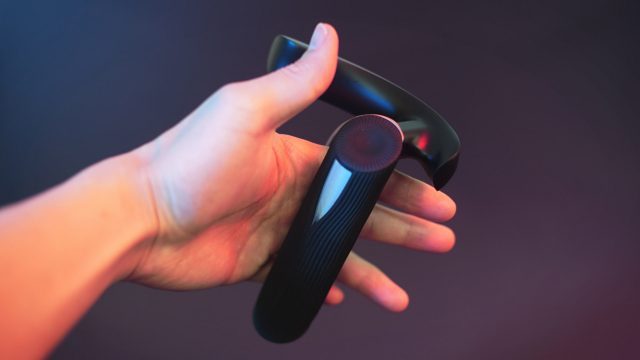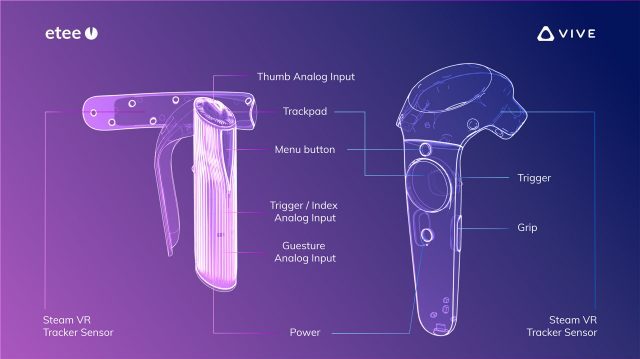London-based hardware startup TG0 launched a Kickstarter campaign earlier last month for the Etee dev kit, a VR controller with integrated SteamVR Tracking. TG0 positions the controller’s button-less design and finger tracking as its main attractions.
Update (May 11th, 2020): The Etee Kickstarter has concluded today, boasting 338 backers pledging a total of £90,650 ($112,000).
Surpassing £90K has unlocked the stretch goal for a formalized developer program, something creator Mick Lin says will include an event where devs will help the company expand Etee’s usecases.
The final funding amount fell just short of the £100K mark, which would have allowed the team to work on Android support.
Update (May 6th, 2020): The Etee Kickstarter campaign for a finger-tracking VR controller with SteamVR Tracking is now 153% funded with £70,450 (~$87,500), having well surpassed its goal of £45,900 (~$56,000). With four days left, the project is approaching the £80,000 (~$100K) mark.
TG0, the creators of the project, recently shared new gameplay footage with Half-Life: Alyx and Boneworks to show how the button-less controllers handle common gaming inputs like shooting guns and moving around the environment:
The project has reached two stretch goals so far—open-source CAD files for the controller’s handle, and an ‘EteeRoom’ demo game—and could reach its third stretch goal at £80,000 which will see the accelerated development of an Unreal Engine SDK for the controllers.
Update (April 14th, 2020): The Etee Kickstarter campaign has exceeded its goal of £45,900 (~$56,000) with nearly four weeks left. Among 190 backers for the controllers, 87% have backed the SteamVR version of the controllers, which is understandable as the base controller doesn’t offer integrated 6DOF tracking. Upon reaching the campaign goal, the creators revealed the first of several stretch goals which will be unlocked as more money is raised.
For the first stretch goal the company has announced that the LED surface on the controllers has two separate sensors which can serve as two touch-sensitive buttons, or a continuous thumb slider. It isn’t clear if this was something the company has added for the stretch goal or is merely explaining in more detail.
For the second stretch goal at £60,000, the company says it will make the available a 3D model of the controller’s handle so that makers and modders can create different handle shapes and accessories.
Four additional stretch goals, each £10,000 higher than the previous, have yet to be revealed.
Earlier this week the company showed off Half-Life: Alyx gameplay with the controllers and shared a Q&A.
Update (April 9th, 2020): One week after the launch of the Etee Kickstarter campaign, the project is nearing its £45,900 (~$56,000) funding goal, currently at 81%. TG0, the company behind the controllers, also announced that it has opened up the campaign to worldwide shipping, allowing developers from all over to back the project.
While the campaign looks on track to reach and exceed its goal, $50,000 doesn’t seem like much for a hardware project of this scope, which likely requires bespoke parts and precise manufacturing. Still, we hope to see the campaign succeed, as more controller options means more choice for developers and potentially for consumers further down the road.
Original Article (April 2nd, 2020): TG0 has launched the Etee Kickstarter campaign with the hopes of raising £45,900 (~$56,000) for its VR controller dev kit. The Etee dev kit will come in two versions, one with 3DOF tracking starting at £200 (~$265) for a pair and another with 6DOF SteamVR Tracking starting at £240 (~$315) for a pair. There’s a range of higher tiers available with more unique rewards, including a version with advanced haptics and another with a cool transparent shell.
Based on a thesis that sounds… downright wrong to the ears of any VR gamer, TG0 says that “buttons are way out of date,” and touts the Etee controller’s button-less, trigger-less, and joystick-less design as its major selling point, alongside finger-sensing, which the company says detects proximity, touch, and pressure.
This is in contrast to the rest of the VR industry which has steadily coalesced around VR controllers and games which make use of use of buttons, triggers, and joysticks for key gaming interactions. TG0 says that Etee supports gestures which can be used in place of buttons.
While removing the reliance on binary controls sounds great on paper, in practice it has proven difficult in the VR gaming space because of the need for precise and highly reliable inputs.
But VR gaming isn’t the only use-case the company is touting for the Etee controllers. As a dev kit, they could of course be used for any application where motion input is useful. Indeed, VR content that doesn’t demand the binary precision of hardcore game experiences—like training, art, therapy, social, remote control, and more—could definitely leverage Etee as a more intuitive means of input than a VR controller covered in unfamiliar buttons, triggers, and sticks. We’ve made a similar point about Oculus Quest’s experimental hand-tracking feature (which of course also lacks buttons, triggers, and sticks).

Though the controllers are a dev kit at this stage, thanks to integration with the SteamVR Input system, the Etee controllers should be technically compatible with SteamVR games out of the box, though we’d expect the need to experiment with custom bindings for many games to reach a point where things are truly playable with the controllers given the need to remap buttons and other controls to Etee’s unique inputs.

TG0 says developers can expect battery life up to 6 hours of continuous use and 14 hours of standby, and that the 3DOF version of the controller weighs 75 grams and the SteamVR Tracking version weighs 120 grams.
The Etee Kickstarter campaign runs until May 11th and the company expects the first ‘Early Bird’ controllers will begin shipping in December 2020.






